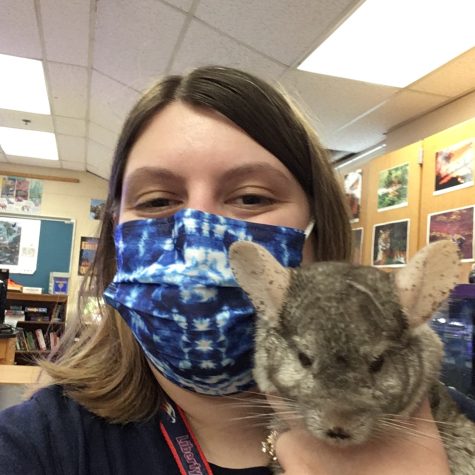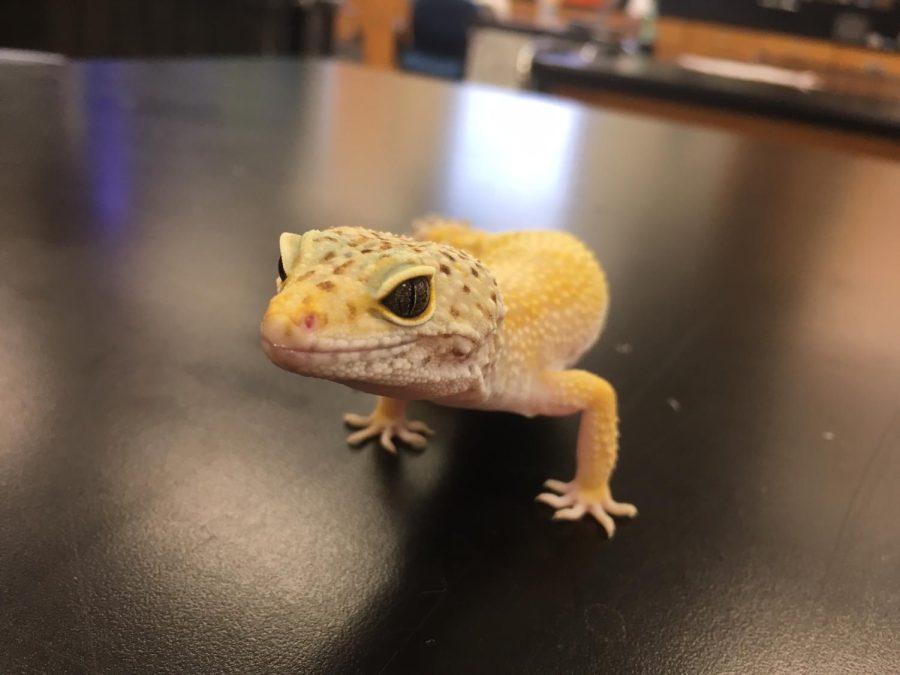Science department animals add value to classroom experience
Mrs. Winkelmann’s classroom is the home of several animals, including this smiling reptile. Photo by Kate Campbell.
March 11, 2022
It’s no surprise people love animals. Liberty High School’s science department pets are proof of that.
Liberty has a few teachers that have pets, but the person with the most is Mrs. Meagan Winkelmann.
Mrs. Winkelmann teaches Marine Science and Ecology. She owns over 100 animals including marine organisms. The marine animals are snails, fish, crabs, coral, shrimp, and anemones. Just counting the hold able ones, she has 13. Those include one corn snake, one leopard gecko, one blue tongue skink, two emerald tree skinks, one chinchilla, two fire skinks, and five hermit crabs.
¨I would say the most popular are the chinchilla and snake,” said Winkelmann. ¨Boo [the chinchilla] appeals to everyone because he is soft, cute, and cuddly and Delilah [the snake] is likely as popular, because she is the most unusual and there is a bit of a thrill associated with her.¨
She went along to say her blue tongue skink is her most underrated pet.
Winkelmann says she spends 1-3 hours a day after school taking care of the animals. The amount of time it takes her depends on what she has to do and she says Fridays are the days it takes her the longest because she has to get them ready for the weekend.
She and the other science teachers do a thing called ¨Critter Care.¨ It is where teachers over long breaks take rotations on coming in to take care of the pets so that they all don’t have to come in many times a week.
None of the pets we have in the school are dangerous but that doesn’t mean they can all be held.
¨The hermit crabs can’t really be held, as this can stress them and Delilah,¨ said Winkelmann.
The only other ones in her room that can’t be held are most of the marine organisms besides the urchins.
¨Classroom pets are a lot of work, time, and most expenses I have to cover myself,¨ said Winkelmann.
She says classroom pets aren’t for everyone and teachers shouldn’t get them unless they have a personal interest in it, because if they aren’t in the mood to do stuff and need a break it’s hard to take a day off.
Although there are some negatives she says the benefits out weigh them.
¨I can have some hands on lessons involving real organisms and students outside of my class, also have the benefit of getting to interact with animals on a more regular basis,” said Winkelmann.
Animals of all kinds can reduce stress and can also build compassion and empathy.
One of the other teachers that have science pets is Mrs. Elizabeth McCaslin. She has fish. She has had them since January 2021 and started a tank, because she had been buying a bunch of fish from the pet store and decided it would be easier just to breed them.
In the tank they also have trumpet snails which are fed to some of the other science teachers, lizards and aquatic plants that are used for some labs.
¨Students sometimes help to test the water quality or feed the fish, the AP class had also used the fish to create and monitor their own little ecosystem made from 2 water bottles which we call ecocolumns,¨ said McCaslin.
The fish don’t have names which makes them hard to tell apart.
¨The fish tank was a great addition to the class because they were entertaining to watch and made me excited to come to class,¨ said freshman Amity Vincent.
Some students love the fish but others have a different opinion.
¨I liked having the fish in class, but sometimes I found myself getting distracted by them,¨ said freshman Ally Rollins.
The science pets in Liberty have a majority of positive impact on the students. Having these pets might be extra work for the teachers, but it seems as though it has been paying off for the most students.



